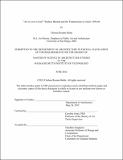"Art is Love is God" : Wallace Berman and the Transmission of Aleph, 1956-66
Author(s)
Behle, Chelsea Ryanne
DownloadFull printable version (1.106Mb)
Alternative title
Wallace Berman and the Transmission of Aleph, 1956-66
Other Contributors
Massachusetts Institute of Technology. Dept. of Architecture.
Advisor
Caroline Jones.
Terms of use
Metadata
Show full item recordAbstract
In 1956 in Los Angeles, California, Wallace Berman, a Beat assemblage artist, poet and founder of Semina magazine, began to make a film. Over ten years, the film now known as Aleph became Berman's personal record, documenting family, friends, Verifax collage artwork and inspirations from popular culture. Paint and Letraset were applied across the film celluloid, creating a palimpsest of code and gesture. Aleph is also delineated with Hebrew letters, representing Berman's interest in the Jewish mystical Cabala. Translated as "tradition," "reception" or "transmission," the Cabala ascribes the word of God with hidden meaning, creating a channel from the divine to the human -- a transmission of secret codes. The core of this thesis frames Wallace Berman's film Aleph as both a transmission and an unfinished, unstable document. The form and content of Aleph enact the process of transmission and represent transmission itself. However, since the film is unfinished, abandoned and left with excess fragments, it possesses unstable meaning. This thesis will not substantiate a stable art object; rather, it will frame a process -- transmission -- through which multiple meanings are carried, and through which the unfinished, unstable film object operates as a catalyst towards one possible unity of message: "Art is Love is God."
Description
Thesis (S.M.)--Massachusetts Institute of Technology, Dept. of Architecture, 2012. This electronic version was submitted by the student author. The certified thesis is available in the Institute Archives and Special Collections. Cataloged from student-submitted PDF version of thesis. Includes bibliographical references (p. 134-144).
Date issued
2012Department
Massachusetts Institute of Technology. Department of ArchitecturePublisher
Massachusetts Institute of Technology
Keywords
Architecture.